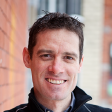
The May workshop of the Energy Futures Lab (EFL) Fellowship marked an important milestone, as the EFL pivots into a second phase of greater visibility and expanding impact.
Deep, effective collaboration is easier said than done, requiring commonality of vision, shared value, and mutual trust.
The pivot is partly a reflection of where we’re at in the Lab process and partly inspired by feedback received from EFL Fellows during a mid-point set of interviews conducted in April. It’s also influenced by the growing support and interest we’re experiencing.
Word of the EFL has spread across the province and beyond. Recognizing the unique blend of deep knowledge and diverse voices represented in the EFL Fellowship, we’re getting invitations for consultation and dialogue. The Fellows’ own organizations are asking them questions. People want to know what we’re doing.
With the launch of Smart Prosperity, a broad federal framework supported by Canadian leaders representing business, think tanks, labour, Indigenous Peoples, youth, and NGO communities “to map out and accelerate Canada’s transition to a stronger, cleaner economy in the next decade” we find the lab perfectly positioned to be at the forefront of this transition.
All of this has shaped the Phase 2 pivot for the EFL, which is marked by the release of the Energy Futures Lab Vision and Innovation Pathways statement (working draft). The pivot will manifest in three main ways:
1. Moving joint action from one-off prototype projects to ongoing working groups
Deep, effective collaboration is easier said than done, requiring commonality of vision, shared value, and mutual trust. The lab was designed to give the fellows the best possible chance of success by taking the time to build relationships, develop robust understanding of the system, and actually practice testing ideas through one-off prototypes.
We’re now set to move from testing and groundwork to collaborative execution. Reaching a general consensus on our Vision Statement signals readiness to unleash our creativity and energy along a number of Innovation Pathways, which will become the organizing structure for various ongoing working groups in the lab. We believe that the investment we’ve made in articulating these pathways will pay dividends in terms of coordination, collective impact, and the ability to expand the circles of engagement beyond the fellowship.
2. A shift in focus from “fellows in the lab” to “the lab in the world”
As described above, the lab up to this point has placed a heavy emphasis on the internal building of the Fellowship from the various leaders that make it up. We’ve been working towards a shared understanding of Alberta’s energy landscape, the principles of the shift that needs to happen, and the social capital to begin working together to make that shift happen.
Now we’re ready to bring to the public our vision of the transition and the pathways we believe will get us there. We will turn our collective voice – honed over the past several months– outward to the rest of Alberta and beyond, engaging our organizations and communities in the effort to realize the energy system that the future requires.
3. From pilot to scale with organizational engagement
A less visible part of the Lab so far has been an organizational engagement pilot project with Suncor. The organizational engagement stream is designed to support the EFL fellows in engaging with their colleagues to help sensitize their organizations to the ideas and innovations arising in the EFL. Through a series of workshops taking place over the past eight months, a team of managers from across Suncor have undergone a process that in many ways mirrors that of the EFL Fellows. They have worked to better understand Suncor`s place in Alberta’s current energy landscape and to jointly consider strategies to position the company for success in the energy system of the future.
Now, based on this work we are developing a structured approach to engaging more organizations in shaping their own energy future and the future of the province.
_____
You’re going to be hearing a lot more about the EFL in the coming months as the Fellows begin the real work of collaborating on tangible projects, reaching out to the public to communicate the work they are doing, and as more industry-leading organizations work with the lab to shape future-fit strategies.
Just as the EFL is poised to take the next step, business, governments and the public are ready for us. This is what we’ve been building toward, and where the really exciting work begins.

Chad Park is the Director of the Energy Futures Lab



